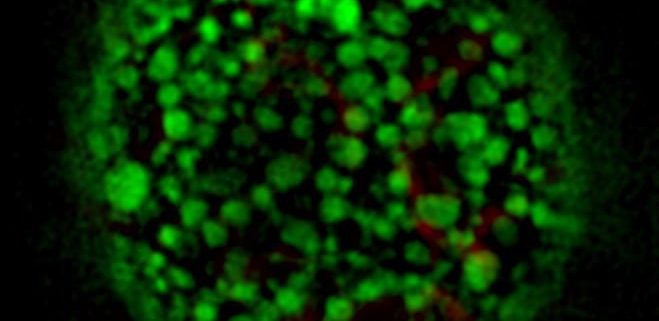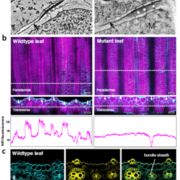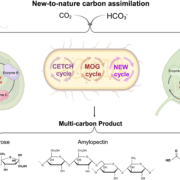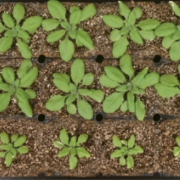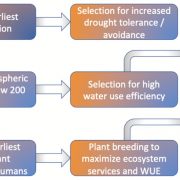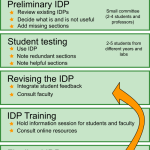A Reversible Switch for Algal Photosynthesis
Roth et al. investigate how a green alga turns photosynthesis off and on when glucose is added and then removed from the culture medium. Plant Cell https://doi.org/10.1105/tpc.18.00742
By Melissa Roth and Krishna Niyogi, University of California-Berkeley
Background: Photosynthesis is the life-sustaining process that plants and algae use to convert sunlight into the chemical energy that fuels the biosphere. It also produces the oxygen and sugars that we humans and other animals depend on. By understanding the factors that control photosynthesis, we can improve agriculture and the production of bioproducts and biofuels by both algae and plants. Algae control photosynthesis and metabolism in response to changes in light and nutrient availability. Glucose, an abundant and preferred carbon source for many organisms, regulates gene expression, metabolism, growth and aging in plants, animals, yeast and bacteria, but its regulatory role in algae is not well understood. We used the unicellular green alga Chromochloris zofingiensis that, unlike the closely related model green alga Chlamydomonas reinhardtii, is able to turn photosynthesis off and on in response to glucose. Chromochloris has recently become an alga of high commercial interest because it can produce both high amounts of lipids for biofuels and the high-value antioxidant, astaxanthin.
Question: We wanted to characterize the physiological, photosynthetic and metabolic changes during the glucose-induced repression and activation of photosynthesis. What are the underlying changes in gene expression controlling this photosynthetic switch in Chromochloris?
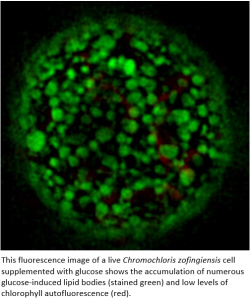 Findings: After just a few days of adding glucose in the light, Chromochloris represses photosynthesis, and the photosynthetic apparatus and membranes decrease. At the same time, cells accumulate biofuel precursors such as lipids and starch and the high-value antioxidant astaxanthin. Within a single day of removing glucose, photosynthesis resumes, and the photosynthetic apparatus reforms. Nearly 1/3 of all genes in the genome are affected by adding and removing glucose. Regulation of these genes is coordinated, reversible, and involves specific changes including repression of photosynthetic pathways and upregulation of lipid and carotenoid (e.g. astaxanthin) biosynthesis.
Findings: After just a few days of adding glucose in the light, Chromochloris represses photosynthesis, and the photosynthetic apparatus and membranes decrease. At the same time, cells accumulate biofuel precursors such as lipids and starch and the high-value antioxidant astaxanthin. Within a single day of removing glucose, photosynthesis resumes, and the photosynthetic apparatus reforms. Nearly 1/3 of all genes in the genome are affected by adding and removing glucose. Regulation of these genes is coordinated, reversible, and involves specific changes including repression of photosynthetic pathways and upregulation of lipid and carotenoid (e.g. astaxanthin) biosynthesis.
Next steps: Our work introduces an algal system with a readily controllable photosynthetic and metabolic switch that provides fundamental insights into photosynthesis and algal biology. Our future work aims to increase the amount of lipids and astaxanthin produced by Chromochloris to improve its commercial prospects for sustainable fuel and other valuable products.
Key words: Chromochloris, photosynthesis, green alga, trophic transitions, astaxanthin, lipids, sugar responses
Melissa S. Roth, Sean D. Gallaher, Daniel J. Westcott, Masakazu Iwai, Katherine B. Louie, Maria Mueller, Andreas Walter, Fatima Foflonker, Benjamin P. Bowen, Nassim N. Ataii, Junha Song, Jian-Hua Chen, Crysten Blaby-Haas, Carolyn Larabell, Manfred Auer, Trent Northen, Sabeeha S. Merchant, Krishna K. Niyogi (2019). Regulation of Oxygenic Photosynthesis during Trophic Transitions in the Green Alga Chromochloris zofingiensis. Plant Cell. https://doi.org/10.1105/tpc.18.00742


